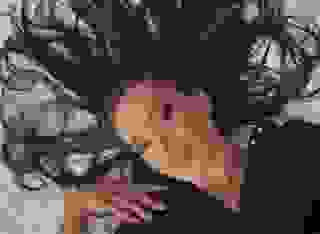- Non-Erotic
- Tagging Hell's Gate
Note: You can change font size, font face, and turn on dark mode by clicking the "A" icon tab in the Story Info Box.
You can temporarily switch back to a Classic Literotica® experience during our ongoing public Beta testing. Please consider leaving feedback on issues you experience or suggest improvements.
Click hereI've gone back and forth on whether or not to post this one—it's not an erotic story, and ESPECIALLY doesn't fit into Loving Wives, my preferred subgenre. On the other hand, the feedback I've gotten on the site—particularly from the notoriously-vicious Loving Wives readers!—has been extremely helpful as I continue to work on my writing. Ultimately, advice from another writer tipped the scales. Thanks, dtiverson for reading—and weighing in!
Copyright B. Watson 2022
The ramp to the Triborough Bridge stretches across Astoria, Queens like the first slope on a roller coaster. Rising steadily over Hoyt Boulevard, the line of traffic picks up speed as it escapes the tangle of city traffic and prepares to leap across the river to Randall's Island, Manhattan and the Bronx.
On that first rise, the bridge is all potential and promise, a ribbon of black asphalt and blue painted steel, arcing over dark water into a bright blue sky. But, looking up from Astoria Park, it's another story. That's where you see the Triborough's secrets—the cracked concrete and peeling paint, the knotted maze of onramps and offramps, and the swirling eddies and whirlpools of the Hell Gate, the slim finger of water that sits hundreds of feet beneath the highway.
At the other end of the park, the Hell Gate Bridge seems like an afterthought, a blotchy dull pink arch anchored by beige towers on either side of the river. Where the Triborough is all ambition and arrogance, the Hell Gate seems soft and shabby.
Viewed from a distance, it looks like a hand-me-down, a dowdy, old-fashioned relic plucked from the English countryside and dropped into the charmless industrial morass of Northern Queens. As you get closer, though, the bridge's scale comes into focus, transforming it from a dainty derelict to a brawling behemoth. Built to carry tons of freight across its broad shoulders, it is solid and sure, made to weather centuries. Its towers weigh heavy, like sturdy castle turrets left over from some medieval border stronghold. Behind, a row of graceful stone arches line up like soldiers keeping watch on the water, lifting the railroad tracks over Astoria's crowded streets and out to Long Island.
In the early 1900s, when the engineers were designing the bridge, one of them mused that carrying a train was—maybe—just part of its purpose. A superstitious man, he thought of the old stories about the ships that had gone down in the Hell Gate, that narrow strip of treacherous water between Astoria and Randall's Island. Looking out over the slow-growing bridge, he felt a chill as he remembered the General Slocum, a sturdy steamboat that had carried over a thousand sturdy German Lutherans out for a day's cruise a few years earlier. The trip had hardly begun before the boat caught fire and sank into the waters of the Hell Gate, leaving almost no bodies to be buried.
But the Slocum was only one of many boats to fall victim to the Gate. The ships that Admiral Howe lost when he decided to brave the Gate during the Revolutionary War. The Hussar, a British frigate that went down in 1780, carrying most of its crew and—supposedly—a belly full of Spanish silver. So many boats. So many people. The water was hungry, the engineer thought as he looked across it and worked on designing a bridge that would keep its appetites at bay.
When the Romans built a bridge, they imprisoned a child in its base, an offering to the gods of the river. Nobody ever spoke of such an offering to the Hell Gate, but the engineer couldn't help but notice the two tiny rooms—each with one thick door and no windows—that the planners had placed in the towers on either side of the water.
It's been over a hundred years since the bridge was built, and nobody alive knows if those rooms were ever used. But there they were, and there they remain—little more than closets, shut tight with steel doors that have long since rusted solid, fused to the stone of the towers.
Meanwhile, under the bridge, the water still pitches and roils in its whirlpools and rapids, raging at the bonds that keep it in place. Kayakers still brave the Hell Gate, testing their muscles and will against the river. Most make it through, arms screaming as they desperately paddle toward the calmer shoals under the Triborough Bridge. Some turn back, seeking an easier passage or a gentle spot where they can put in on the shores of Randall's Island.
And—every once in a while—the Hell Gate wins, pulling another boat down into its eager embrace.
*
As Silla Ramirez walked the concrete path along the edge of the river, she barely noticed the Hell Gate Bridge. She could navigate the walkway with her eyes closed, guided by the cool shadows under the Triborough, the funk of the trashcans that always seemed to be overflowing, and the tinkling of the water brushing against the broken glass on the scrubby beach a few feet below. As long as she could remember, Silla had walked this path with her father, watching the bridge's rusty pink span slowly growing larger as she got closer to it. If she had ever felt wonder at its size, that awe was long gone, replaced by something that felt more like love and security. Hell Gate was home.
Today, her mind wasn't on the bridge—it was on logistics. Her plan to escape school was blessedly simple, but not without its flaws. After fourth period calculus, which she couldn't afford to skip, she had cornered Mr. Whitford, the milky-skinned Assistant Principal, and asked him for a pass to go home. When he asked why, she had clenched her teeth and told him that she was feeling crampy. She had barely restrained a smile as he had hurriedly scribbled the note that was her ticket to freedom.
But while Mr. Whitford was an easy mark, the school secretary, Mrs. Gomez, wasn't, and Silla had seen a sharp look in her eyes when she filled out the attendance book. Silla's dad wasn't home, but it wasn't too hard to imagine Mrs. Gomez tracking down his work number to rat her out. Silla had never ditched school before, and it all seemed a bit too easy, a baited trap waiting to spring.
She was also worried about Juan. He hung out with the Hawks, a gang of graffiti writers that had tagged half the murals in Astoria. They were talentless but pushy, quick to cover over other people's art if they thought they could get away with it. Their sloppy white initials were everywhere, like the drippy piss stains of a pack of dogs marking their territory.
At lunch, Juan had elbowed her as she was going into the school cafeteria. When she whipped around, a sneer crossed his face. "Watch where you're going," he muttered. "Hawks eat little birds."
She could hear her heart in her ears as she looked up at him. A few days earlier, she'd painted a little sparrow on the concrete at the base of the Hell Gate tower. It wasn't perfect—she couldn't quite capture the way the left wing looked as it trailed below his body—but it was the first real painting she'd ever done, and she felt almost embarrassingly proud of it. She'd based it on the first bird she'd seen that Spring and something in her mural captured the joy she'd felt when she'd spied it in the park. As Juan's words sunk in, she knew that her little bird was gone. That's when she decided that she couldn't stay in school any more that day.
When Silla finally got to the base of the bridge, she wished she hadn't come. Her little bird was gone, replaced by a crude portrait of a boy's face.
Juan had covered a good-sized stretch of the wall in black paint, then worked it over with bright colors, sketching out a wide-eyed kid smiling out at the water. She knew the kid—rather, she had known him—it was Juan's cousin Jerry. He had been hit by a bus a year earlier.
Jerry had been a good kid, kind and gentle, but the mural didn't show any of that. Juan had painted him head on, staring forward like a mugshot. The eyes were wide and uneven, showing too much white and tainting what was supposed to look like joy with something darker. As for the smile, it was too wide, the teeth shiny and glistening.
Against the black background, Jerry looked mad and mindless, the kind of kid who tore the wings off butterflies or stuck firecrackers up a cat's ass. It was supposed to be a tribute, but it was like a picture of the anti-Jerry, a monster child who had stolen his soft features and gentle smile, replacing them with hunger and mania. It was an insult to her and an insult to the little sparrow. Most of all, it was an insult to Jerry.
Eyes narrowed, Silla pulled the cans of spray paint out of her backpack. Before she had time to think about it, she was changing the picture into something that no longer looked like Jerry at all. Horns the color of dried blood, poking through his black hair. Dark sunglasses, covering those evil eyes. Sharp cheekbones over that mad mouth. White shirt. Black tie.
A few minutes later, Jerry was gone, replaced by a horned stockbroker with a crooked smile. She smiled back. This guy looked like a young Tom Cruise, confident and handsome, with a shock of dark hair and an arrogant smirk. The madness Juan had painted was still there, but she had transformed it into something more calculating, more evil. It wasn't perfect—she hadn't drawn too many faces, and the cheekbones looked a little off—but at least it wasn't Jerry.
Revenge was sweet, but it didn't bring her little bird back. Her first real painting, and now it was gone, another layer of paint on the stained concrete below the bridge. Someday, archeologists might find it as they excavated the centuries of art on the bridge, but it was more likely that it would end up stripped away by a crew of city cleaners, washed into the river on a swirl of suds and solvent.
Silla couldn't even blame Juan—if he hadn't erased her bird, somebody else would have covered it over with a clever design or a little wyldstyle writing. If she was a legendary painter like Tracey 168, or one of the tougher gangs, like the Busybees, it might have stayed for few years, getting regular touch ups, but sooner or later some brave soul would still have tagged it or it would have flaked in the salt air. Some flaw or weakness would appear, followed by others, until the painting disappeared forever.
Art dies in Hell Gate, Silla thought.
Every year, she'd seen the paintings change, transforming with new tastes and new graffiti writers. She took pictures of her favorites, but they couldn't capture the wonder of the art: their scope seemed shrunken on her little phone screen, their colors muted by the transmutation from real life into flat rows of glowing pixels. Her camera could capture a hint of their beauty and a bit of their burning rage, but it could never show their life, the vibrance of new paint and bold designs that changed every season.
Standing there, mourning her little bird, Silla had the idea. The one that would last—at least for a little while.
Half an hour later, she was back at the apartment she shared with her father, a dozen cans of spray paint and a coil of rope from the dollar store tucked into the bottom of her backpack.
*
When Silla's dad got home at six, he found her working on her homework at the kitchen table. He asked about her half day, and the suspicion in his voice told her that Mrs. Gomez had, indeed, gotten to him. But he wasn't much better than Mr. Whitford when it came to matters of female anatomy, so after briefly quizzing her about her trip home from school, he signed her note and breathed an obvious sigh of relief when she switched topics. By the time they were halfway through dinner, her early departure from school was forgotten.
At 9:30, Silla told him she was turning in early, and he barely glanced up from his book as she gave him a kiss goodnight.
Silla's dad believed in a firm schedule—home at six, dinner at seven, bed by ten, asleep by half past—and she'd barely been in bed for twenty minutes before the light went off under her door. She waited another ten minutes before she decided it was time. As quietly as she could, she hoisted up her window and climbed out onto the fire escape. A few minutes later, she was on the street.
Walking to the park, she thought about the writing she planned to do. That's what they called it in the neighborhood—writing. Graffiti was an outsider word, the word of the city workers who scrubbed it off the subway platforms or the teachers who complained whenever someone tagged the street signs near the school. Once in a while, she'd hear a tourist or one of the new people in the neighborhood use the word when they talked about the writing over on Welling Court, where the real artists put up their work and even the Hawks feared to fly. When those people said "graffiti," she could hear the respect in their voices, and it felt weird to her. Graffiti was the word you used when you wanted to make the tags disappear, not when you were marveling at their artistry.
But, regardless of whether you called it graffiti or writing or murals, the paintings would only last for a little while, unless there was somebody watching out for them. The storekeepers on Welling Court would scream if a kid so much as pulled out a paint can, and nobody would touch anything done by the Bee Squad—there were dark tales about things that happened to kids who crossed that gang. But for independents like Silla, the most she could hope for was a couple of weeks in the sun before her work drowned under a fresh wave of paint.
But tonight's work was going to change that, Silla thought. Tonight's work was going to last for—well, maybe not forever—but for a long time.
When she got to the Hell Gate, she noticed that somebody had already tagged her sunglass-wearing demon. That was the first step: soon, there would be another tag, then another and another. By the end of the week, the painting would be completely covered—if it wasn't totally painted over with something new.
Silla shook her head as she climbed up to the bridge. For all its tangle of stone and steel, the bridge's design was pretty simple: It had two long, curving arcs of pink-painted steel that stretched like a double rainbow between the sandstone towers on either side of the river. Suspended between them was a flat stretch of girders holding the train tracks.
The sandstone towers were each set in a block of poured concrete. On the Astoria side, the block was slick from years of paint and the slow drip of water from the girders above, so climbing straight up it was not going to happen. But there was a soft hill sloping up from the road, and at the top, it almost reached the top of the concrete base. From the top of the hill, Silla could easily step onto the foot-wide lip at the top of the concrete base, thread her way to the side facing the road, and clamber on to the bottom arc of the bridge. Then, it was just a 40-foot shimmy up the bottom curve of the bridge to the railroad platform at the top.
Easy as pie. At least, that's what she told herself.
In reality, it was a slow, terrifying crawl: the bottom arc of the bridge looked like a graceful slope from a distance, but it felt a lot sharper when she was dragging her body across its rough rivets and rusty metal supports. Looking down, she could see the hillside dropping away past the narrow road to the riverbank and the water below. The moonlight glittered off the broken glass on the beach.
Crawling across the girder felt like an eternity, especially when she looked down. She stopped looking down.
When Silla finally got to the flat train platform, it was only a matter of grasping hold of the edge of the bridge and hauling herself up. There was a narrow walkway outside the train tracks, giving her plenty of room to work, and she sat on it as she pulled out her supplies. The rope was stiff, rough nylon stuff that wouldn't tear on the girders; as she coiled it, she knew it was more than long enough for what she needed.
The plan was simple: There was probably a hundred feet of flat bridge suspended between the curved girder, plenty of space for her message. She would write it on the side of the bridge, in letters four feet high—big enough to be seen from the shore. Hell, big enough to be seen from the Triborough, if you had sharp eyes. The message was simple: Art is Forever.
Of course, it wasn't really going to last forever, but it had been decades since the last time the bridge was painted, and the city didn't seem to be in a hurry for a repeat performance. The only thing she really had to worry about was Juan, but he was all flash and no guts. There was no way he was brave enough to climb the bridge to tag her message. Hell, he'd be lucky to make it halfway up the first girder!
She walked about two thirds of the way across the bridge, to where its lower arch met the train tracks on the other side. She'd never gone rock climbing, but the basic idea seemed pretty simple: she needed to find a way to tie herself to one of the girders securely enough to keep from falling into the river. The bridge end of the rope seemed simple—she just needed to wrap the rope around one of the girders a couple of times, with a few knots to keep it from unraveling. She wrapped it six times, with three knots, just to be sure.
The other end—the one that attached to her—was harder, but she tied a loop that was just a little wider than her waist, then added a couple more loops that could go between her legs, sort of like a rope diaper. She pulled the knots tight, making sure they wouldn't slip. Then she tied a couple more knots, just to be sure. When she tried it on, it felt perfect—the front knot hit just above her belly button.
Now came the hard part: She needed a way to control her descent. She threw the sling over the side of the bridge, then pulled up the rope until it was at the right height. She wrapped the excess around the girder so it wouldn't come loose.
It wasn't pretty, but it would do the job, Silla thought. She felt a light, panicked laugh trying to bubble up: this was crazy, but she was here, she had the paint and the rope, and it was time to take her shot. With any luck, she'd be done by morning, with an untouchable painting, a couple of rope burns, and a great story that she probably couldn't tell anybody.
The first two letters came pretty easy: she stepped into the sling and lowered herself over the side. She was just a little bit below where she'd planned on ending up, but by reaching high, she was able to paint the tops of her letters. There was almost no wind, so her spray came out clean and true.
The A was simple: two straight lines, meeting at the top, without any clever swoops or twists. She outlined the edges, then did the fill, spraying back and forth, careful not to drip, until the letter was finished. It took a while, but it wasn't hard. In fact, she was surprised at how comfortable she felt, hanging hundreds of feet over the water with a can of paint in her hand.
Pulling herself up to the edge of the bridge, she repositioned her rope so she would dangle a few feet to the right, far enough to paint the R. She lowered herself again and started in. This time, it was even easier: the R was tougher than the A, but she was starting to get used to hanging off the bridge, and her hand was steady as she put up her edges and fill.
To get the T, Silla needed to move the rope to the next girder. Untying it, then retying it, she glanced at her watch. The first two letters had taken just over twenty minutes, with another ten minutes to tie the rope. So maybe 15-20 minutes per letter. Multiplied by ten more letters, with a little extra time thrown in for good measure, she was looking at about two hours. Add in travel time, and she could be in bed by 3, 3:30 at the latest. She might even get some sleep tonight.








